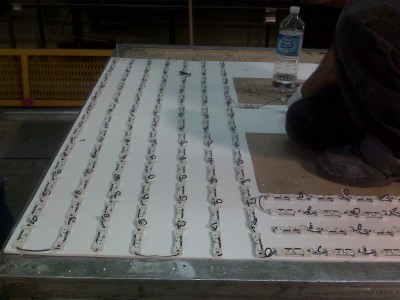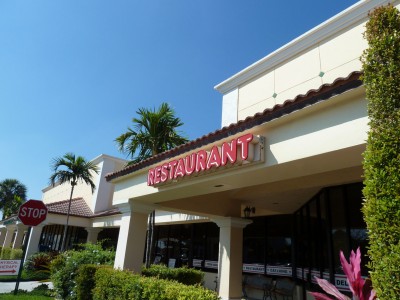Expanding adhesive products and practices
by Matthew | 1 May 2012 3:55 pm
 [1]
[1]Photo courtesy Chemical Concepts
By Andrew Morris
With both advances in new technology and constant innovation in the use of existing materials and techniques, the sign industry has seen rapid change in the implementation of adhesives, including structural adhesives as an alternative to welding and mechanical fasteners in fabrication processes. The competitive advantages of anchoring adhesives, anchoring adhesives and cyanoacrylates or ‘super glues’ may not all be widely known, but they have been well-established through decades of use.
Many signmakers still rely on mechanical means of fastening structural components and could benefit from reduced costs, greater esthetic appeal and even improved performance by using modern adhesives and techniques. Indeed, as the industry’s awareness of adhesive products and practices continues to grow, more and more sign fabricators are turning to them.
Protecting LEDs
With the rise of light-emitting diode (LED) technology in the sign industry, fabricators have adopted potting and encapsulation materials to mount and protect LEDs. Presently, only professionals who specialize in LED production and installation tend to be familiar with the adhesives available for these applications, but as demand for energy-efficient illuminated signs increases, the awareness and use of these materials will become more commonplace.
LED technology is also becoming increasingly important as the public becomes more accustomed to high-resolution moving images, from computer monitors to TVs to smart phone screens. Full-colour LED-based video boards are the sign industry’s answer to this high-tech environment, capable of capturing the attention of the modern consumer.
Potting and encapsulation are probably the best measures for the protection of LED components. They involve engulfing a component or assembly with a solid or gelatinous material. This process offers many potential benefits, including heat dissipation, ultraviolet (UV) resistance, shock absorption, protection from moisture, enhanced light transmittance, chemical resistance and greater ease of use and repair.
Many types of materials can be used for potting and encapsulation, such as urethane, epoxy and acrylic. Silicone is probably the best option for LEDs, due to its non-reactivity, its UV resistance and the availability of optically clear and non-yellowing formulations.
Silicone is available in a wide range of hardnesses (as measured with a durometer), from gels to roughly the equivalent of a pencil eraser. Some silicone gels are self-healing, meaning the potted components will still be accessible should repairs, maintenance or modifications become necessary. It is very important to select the right silicone product, as some formulations are considered corrosive and can degrade an LED over time.
Most silicone potting compounds are available in two-part systems, consisting of a base and a catalyst. Some are available in integrated cartridge dispensing systems, much like those used for common structural adhesives. This type of system uses an adhesive cartridge, a manual or pneumatic dispensing gun and a static mixer or ‘mixing tip.’ The material is mixed as it is dispensed, for fast and easy application.
Assembling channel letters
The fabrication of channel letters, whether they use LEDs or another source of interior or rear illumination, remains a major part of the sign industry. Conventional techniques involving cutting a raw material—usually aluminum—into the desired letter shapes and then assembling the final products using screws, rivets or welding. These fastening techniques present some key disadvantages.
 [2]
[2]Light-emitting diodes (LEDs) used in signmaking are protected by potting and encapsulation adhesives. File photos
Welding is a costly, time-consuming process that requires specialized training. It achieves full load-bearing strength almost instantly, yet it frequently results in burned or distorted substrates that need extensive post-production reworking. Screws, rivets and bolts, meanwhile, often call for additional joint designs, raw materials for tongues or flanges, pre-drilling and/or filling in screw heads—not to mention the cost of the fasteners themselves.
It is possible today to assemble channel letters using only adhesives. In the past, one of the hurdles was how long it took to achieve load-bearing strength. Acrylic adhesives can cure rather quickly, usually with a handling time—i.e. the period until bonded piece can be moved or handled without breaking the bond—of around 10 minutes. To compensate, special acrylic-based hot-melt adhesives are applied to serve as a ‘clamp down’ device, holding the pieces in place as the structural adhesive cures.
This system has many advantages. It requires no specialized training and very little surface preparation, is esthetically pleasing and involves no damage to the materials. Any stresses will be distributed evenly across the bond line, rather than concentrated in small areas, resulting in greater overall strength.
In addition to substantial savings over welding in terms of time and labour, this process also uses less expensive associated equipment and allows for the use of thinner sheets of aluminum, reducing material costs.
Installing channel letters
Adhesives can also be used for the installation of channel letters and other types of signs into a wall.
First, surface-mount fasteners are bonded to the backs of the letters or sign. These replace the need for drilling or stud welding.
Next, threaded rods of the desired length are attached to the studs. A thread-locking material can be used for additional strength.
Holes are drilled into the wall and filled with an epoxy or anchoring adhesive. While 100 per cent silicone adhesives have sometimes been recommended for this type of application, it is better to select a true structural adhesive.
 [3]
[3]Many of today’s channel letters are assembled and installed with adhesives. Photos courtesy Chemical Concepts
Finally, the sign is placed on the wall, pushing the threaded rods into the adhesive in the drill holes. The backs of the channel letters can either be installed flush to the wall surface or set out using standoffs for consistent spacing from the wall. It will be necessary to temporarily secure the sign with tape or other means while the adhesive fully cures.
For indoor sign installations with lighter loads, double-sided acrylic foam tapes can be used. Installation is easy and the foam tape provides an excellent bond with a clean appearance. It is particularly well-suited for joining dissimilar materials, as the malleable foam allows for differences in thermal expansion in the joint.
Acrylic formulations
Not all acrylic-based adhesives are created equal. Different formulations are available that set at a variety of different speeds and some offer particularly strong resistance to high temperatures. If a powdercoated finish is desired, for example, the sign fabricator must be careful to select an adhesive that can withstand the temperatures associated with this process.
The ‘working time’ or ‘open time’ of an adhesive is the period during which it can be applied and parts can be mated before it begins to set. This is not to be confused with handling time.
Acrylic adhesives are available with working times as short as two minutes and as long as 45 minutes. The latter are most useful when working with larger pieces, where more time is required to apply enough adhesive before two components can be joined. Unlike an epoxy, the speed at which an acrylic adhesive cures does not have a significant effect on the eventual strength of the bond.
One of the common mistakes when using structural adhesives is to push the two components together with too much force. This can squeeze out the adhesive from between their surfaces, resulting in an inadequately thick bond line.
To prevent this problem, some adhesive manufacturers have mixed tiny ‘micro beads’ of glass into their products. The thickness of these beads ensures an adequate bond line, reducing the impact of operator error during the bonding process. The beads also function as ball bearings, aiding in the repositioning of the parts during the adhesive’s open time.
Product selection
There are innumerable uses for adhesives in the fabrication of signs. As in other production disciplines, the most important tool is knowledge, as selecting the right adhesive for the job will usually mean the difference between structural failure and success. Considerations for a sign shop will include substrate chemistry, temperature, joint design, working time, cure time, colour, surface preparation, thermal expansion, safety and local ordinances.
 [4]
[4]With adhesives, any stresses are distributed evenly along bond lines, enhancing the load-bearing strength of channel letter installations.
As such, it is important to learn about different adhesives and their characteristics. They can roughly be divided into structural and non-structural types. Simply put, a structural adhesive has sufficient strength to bear a considerable load.
Structural adhesives can be further divided into three main groups: acrylics, epoxies and urethanes. Non-structural adhesives include anaerobics, contact adhesives, cyanoacrylates, hot melts, emulsion adhesives, rubber cements, solvent adhesives and sealants, in addition to other, less common types. It is also beneficial to have a working knowledge of industry-standard sign materials and their respective properties. Adhesive manufacturers and distributors should offer free consultation for both the selection and the application of their products.
Surface preparation is often minimal, but a clean, dry and rough surface is generally recommended to ensure a strong bond. Joint design should also be considered, as these principles often differ for an adhesive joint compared to a mechanical joint. Adhesive joints are designed to maximize surface contact area and to minimize exposure to stresses like peeling and cleaving.
From LED potting to structural adhesives, new technologies and applications are constantly being developed. As the demands of the sign industry change, so too will the means of construction and installation. An increased familiarity with these chemicals and their uses can only serve to improve the end products and boost profits for sign shops. Ongoing education about modern adhesive products and practices is a worthwhile investment.
Andrew Morris handles inside sales for Chemical Concepts, which distributes adhesives, silicones, specialty chemicals and fasteners. For more information, visit www.chemical-concepts.com[5].
- [Image]: http://www.signmedia.ca/wp-content/uploads/2014/02/starbucks.jpg
- [Image]: http://www.signmedia.ca/wp-content/uploads/2014/02/Insert-2.jpg
- [Image]: http://www.signmedia.ca/wp-content/uploads/2014/02/walmart.jpg
- [Image]: http://www.signmedia.ca/wp-content/uploads/2014/02/P1000373.jpg
- www.chemical-concepts.com: http://www.chemical-concepts.com
Source URL: https://www.signmedia.ca/expanding-adhesive-products-and-practices/